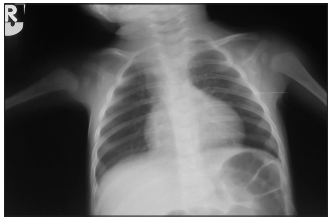DiGeorge syndrome with microdeletion of chromosome 21
Main Article Content
Abstract
DiGeorge syndrome consists of abnormalities of the parathyroid, thymus and the kidneys. It also includes facial dysmorphism and cardiac defects. It is caused by a microdeletion of the long arm of chromosome 22 and occasionally chromosome 10. The case of a 12-week-old female infant with low set ears, retrognathia, micrognathia, high-arched palate, right-sided aortic arch, hypocalcaemia and truncus arteriosus which are all typical of DiGeorge syndrome and an unusual microdeletion of chromosome 21 is presented.
Downloads
Article Details
The journal grants the right to make small numbers of printed copies for their personal non-commercial use under Creative Commons Attribution-Noncommercial-Share Alike 3.0 Unported License.
References
1. Wilson DI, Cross IE, Burn J. Minimum prevalence of chromosome 22q11 deletion. Am J Hum Genet 1994;55:A169.
2. Devriendt K, Fryns JP, Mortier G, van Thienen MN, Keymolen K. The annual incidence of DiGeorge/velocardiofacial syndrome. J Med Genet 1998;35:789‑90.
3. Mølsted K, Boers M, Kjaer I. The morphology of the sella turcica in velocardiofacial syndrome suggests involvement of a neural crest
developmental field. Am J Med Genet A 2010;152A: 1450‑7.
4. Ryan AK, Goodship JA, Wilson DI, Philip N, Levy A, Seidel H, et al. Spectrum of clinical features associated with interstitial chromosome 22q11 deletions: A European collaborative study. J Med Genet 1997;34:798‑804.
5. National Population Commission (NPC) [Nigeria] and ICF International 2014. Nigeria Demographic and Health Survey. Abuja, Nigeria, and Rockville Maryland, USA: NPC and ICF International; 2013. Available from: https://www.dhsprogram.com/pubs/pdf/FR293/FR293.pdf. [Last accessed on 2017 Mar 20].
6. Sieberer M, Runte I, Wilkening A, Pabst B, Ziegenbein M, Haltenhof H, et al. Spectrum of neuropsychiatric features associated with velocardiofacial syndrome (Deletion 22q11.2). Fortschr Neurol Psychiatr 2006;74:263‑74.
7. DiGeorge AM. Discussion of paper by Cooper MD, Peterson RDA and Good RA: A new concept of the cellular base of immunology. J Pediatr 1965;67:907.
8. Lischner HW. DiGeorge syndrome(s). J Pediatr 1972;81:1042‑4.
9. Desmaze C, Scambler P, Prieur M, Halford S, Sidi D, Le Deist F, et al. Routine diagnosis of DiGeorge syndrome by fluorescent in situhybridization. Hum Genet 1993;90:663‑5.
10. Marino B, Digilio MC, Toscano A, Anaclerio S, Giannotti A, Feltri C, et al. Anatomic patterns of conotruncal defects associated with deletion
22q11. Genet Med 2001;3:45‑8.
11. Kiel EA, Drummond WH, Barrett DJ. Prevalence of T‑lymphocyte abnormalities in infants with congenital heart disease. Am J Dis Child
1984;138:143‑6.
12. Choi JH, Shin YL, Kim GH, Seo EJ, Kim Y, Park IS, et al. Endocrine manifestations of chromosome 22q11.2 microdeletion syndrome. Horm Res 2005;63:294‑9.
13. Piliero LM, Sanford AN, McDonald‑McGinn DM, Zackai EH, Sullivan KE. T‑cell homeostasis in humans with thymic hypoplasia due to chromosome 22q11.2 deletion syndrome. Blood 2004;103:1020‑5.
14. HirotaniA, Morimoto S, KohE, Ogihara T. Partial DiGeorge syndrome at the age of thirty‑four. Intern Med 1994;33:418‑21.
15. Perez E, Sullivan KE. Chromosome 22q11.2 deletion syndrome (DiGeorge and velocardiofacial syndromes). Curr Opin Pediatr 2002;14:678‑83.
16. Tinkel‑Vernon H, Finkernagel S, Desposito F, Pittore C, Reynolds K, Sciorra L, et al. Patient with a deletion of chromosome 21q and minimal
phenotype. Am J Med Genet A 2003;120A:142‑3.


